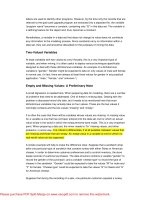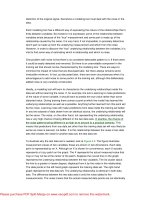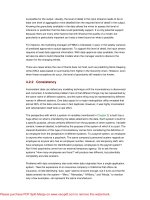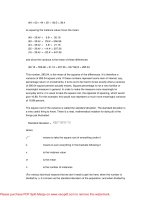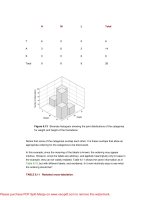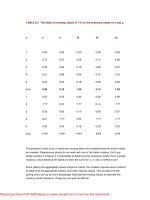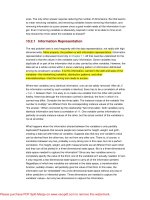Data Preparation for Data Mining- P4
Bạn đang xem bản rút gọn của tài liệu. Xem và tải ngay bản đầy đủ của tài liệu tại đây (352.88 KB, 30 trang )
distortion of the original signal. Somehow a modeling tool must deal with the noise in the
data.
Each modeling tool has a different way of expressing the nature of the relationships that it
finds between variables. But however it is expressed, some of the relationship between
variables exists because of the “true” measurement and some part is made up of the
relationship caused by the noise. It is very hard, if not impossible, to precisely determine
which part is made up from the underlying measurement and which from the noise.
However, in order to discover the “true” underlying relationship between the variables, it is
vital to find some way of estimating which is relationship and which is noise.
One problem with noise is that there is no consistent detectable pattern to it. If there were,
it could be easily detected and removed. So there is an unavoidable component in the
training set that should not be characterized by the modeling tool. There are ways to
minimize the impact of noise that are discussed later, but there always remains some
irreducible minimum. In fact, as discussed later, there are even circumstances when it is
advantageous to add noise to some portion of the training set, although this deliberately
added noise is very carefully constructed.
Ideally, a modeling tool will learn to characterize the underlying relationships inside the
data set without learning the noise. If, for example, the tool is learning to make predictions
of the value of some variable, it should learn to predict the true value rather than some
distorted value. During training there comes a point at which the model has learned the
underlying relationships as well as is possible. Anything further learned from this point will
be the noise. Learning noise will make predictions from data inside the training set better.
In any two subsets of data drawn from an identical source, the underlying relationship will
be the same. The noise, on the other hand, not representing the underlying relationship,
has a very high chance of being different in the two data sets. In practice, the chance of
the noise patterns being different is so high as to amount to a practical certainty. This
means that predictions from any data set other than the training data set will very likely be
worse as noise is learned, not better. It is this relationship between the noise in two data
sets that creates the need for another data set, the test data set.
To illustrate why the test data set is needed, look at Figure 3.2. The figure illustrates
measurement values of two variables; these are shown in two dimensions. Each data
point is represented by an X. Although an X is shown for convenience, each X actually
represents a fuzzy patch on the graph. The X represents the actual measured value that
may or may not be at the center of the patch. Suppose the curved line on the graph
represents the underlying relationship between the two variables. The Xs cluster about
the line to a greater or lesser degree, displaced from it by the noise in the relationship.
The data points in the left-hand graph represent the training data set. The right-hand
graph represents the test data set. The underlying relationship is identical in both data
sets. The difference between the two data sets is only the noise added to the
measurements. The noise means that the actual measured data points are not identically
Please purchase PDF Split-Merge on www.verypdf.com to remove this watermark.
positioned in the two data sets. However, although different in values, note that by using
the appropriate data preparation techniques discussed later in the book (see, for example,
Chapter 11), it can be known that both data sets do adequately represent the underlying
relationship even though the relationship itself is not known.
Figure 3.2 The data points in the training and test data sets with the underlying
relationship illustrated by the continuous curved lines.
Suppose that some modeling tool trains and tests on the two data sets. After each attempt
to learn the underlying relationship, some metric is used to measure the accuracy of the
prediction in both the training and test data sets. Figure 3.3 shows four stages of training,
and also the fit of the relationship proposed by the tool at a particular stage. The graphs
on the left represent the training data set; the graphs on the right represent the test data
set.
Figure 3.3 The four stages of training with training data sets (left) and test data
sets (right): poor fit (a), slightly improved fit due to continued training (b),
near-perfect fit (c), and noise as a result of continued training beyond best fit point
(d).
Please purchase PDF Split-Merge on www.verypdf.com to remove this watermark.
In Figure 3.3(a), the relationship is not well learned, and it fits both data sets about equally
poorly. After more training, Figure 3.3(b) shows that some improvement has occurred in
learning the relationship, and again the error is now lower in both data sets, and about
equal. In Figure 3.3(c), the relationship has been learned about as well as is possible from
the data available, and the error is low, and about equal in both data sets. In Figure 3.3(d),
learning has continued in the training (left) data set, and an almost perfect relationship
has been extracted between the two variables. The problem is that the modeling tool has
learned noise. When the relationship is tried in the test (right) data set, it does not fit the
data there well at all, and the error measure has increased.
As is illustrated here, the test data set has the same underlying “true” relationships as the
training data set, but the two data sets contain noise relationships that are different.
During training, if the predictions are tested in both the training and test data sets, at first
the predictions will improve in both. So the tool is improving its real predictive power as it
learns the underlying relationships and improves its performance based on those
relationships. In the example shown in Figure 3.3, real-world improvement continues until
the stage shown in Figure 3.3(c). At that point the tool will have learned the underlying
relationships as well as the training data set allows. Any further improvement in prediction
will then be caused by learning noise. Since the noise differs between the training set and
the test set, this is the point at which predictive performance will degrade in the test set.
This degradation begins if training continues after the stage shown in Figure 3.3(c), and
ends up with the situation shown in Figure 3.3(d). The time to stop learning is at the stage
in Figure 3.3(c).
As shown, the relationships are learned in the training data set. The test data set is used
as a check to try to avoid learning noise. Here is a very important distinction: the training
data set is used for discovering relationships, while the test data set is used for
discovering noise. The instances in the test data set are not valid for independently testing
any predictions. This is because the test data has in fact been used by the modeling tool
as part of the training, albeit for noise. In order to independently test the model for
predictive or inferential power, yet another data set is needed that does not include any of
the instances in either the training or test data sets.
So far, the need for two learning sets, training and test, has been established. It may be
that the miner will need another data set for assessing predictive or inferential power. The
chances are that all of these will be built from the same source data set, and at the same
time. But whatever modifications are made to one data set to prepare it for modeling must
also be made to any other data set. This is because the mining tool has learned the
relationships in prepared data. The tool has to have data prepared in all data sets in an
identical way. Everything done in one has to be done in all. But what do these prepared
data sets look like? How does the preparation process alter the data?
Figure 3.4 shows the data view of what is happening during the data preparation process.
Please purchase PDF Split-Merge on www.verypdf.com to remove this watermark.
The raw training data in this example has a couple of categorical values and a couple of
numeric values. Some of the values are missing. This raw data set has to be converted
into a format useful for making predictions. The result is that the training and test sets will
be turned into all numeric values (if that is what is needed) and normalized in range and
distribution, with missing values appropriately replaced. These transformations are
illustrated on the right side of Figure 3.4. It is obvious that all of the variables are present
and normalized. (Figure 3.4 also shows the PIE-I and PIE-O. These are needed for later
use.)
Figure 3.4 Data preparation process transforms raw data into prepared training
and test sets, together with the PIE-I and PIE-O modules.
3.1.2 Step 2: Survey the Data
Mining includes surveying the data, that is, taking a high-level overview to discover what
is contained in the data set. Here the miner gains enormous and powerful insight into the
nature of the data. Although this is an essential, critical, and vitally important part of the
data mining process, we will pass quickly over it here to continue the focus on the process
of data preparation.
3.1.3 Step 3: Model the Data
In this stage, the miner applies the selected modeling tool to the training and test data
sets to produce the desired predictive, inferential, or other model desired. (See Figure
3.5.) Since this book focuses on data preparation, a discussion of modeling issues,
methods, and techniques is beyond the present scope. For the purposes here it will be
assumed that the model is built.
Please purchase PDF Split-Merge on www.verypdf.com to remove this watermark.
Figure 3.5 Mining the inferential or predictive model.
3.1.4 Use the Model
Having created a satisfactory model, in order to be of practical use it must be applied to
“live” data, also called the execution data. Presumably, it is very similar in character to the
training and test data. It should, after all, be drawn from the same population (discussed in
Chapter 5), or the model is not likely to be applicable. Because the execution data is in its
“raw” form, and the model works only with prepared data, it is necessary to transform the
execution data in the same way that the training and test data were transformed. That is
the job of the PIE-I: it takes execution data and transforms it as shown in Figure 3.6(a).
Figure 3.6(b) shows what the actual data might look like. In the example it is variable V4
that is missing and needs to be predicted.
Figure 3.6 Run-time prediction or inferencing with execution data set (a). Stages
that the data goes through during actual inference/prediction process (b).
Variable V4 is a categorical variable in this example. The data preparation, however,
transformed all of the variables into scaled numeric values. The mined model will
Please purchase PDF Split-Merge on www.verypdf.com to remove this watermark.
therefore predict the result in the form of scaled numeric values. However, the prediction
must be given as a categorical value. This is the purpose of the PIE-O. It “undoes” the
effect of the PIE-I. In this case, it converts the mined model outputs into the desired
categorical values.
The whole purpose of the two parts of the PIE is to sit between the real-world data, cleaning
and preparing the incoming data stream identically with the way the training and test sets
were prepared, and converting predicted, transformed values back into real-world values.
While the input execution data is shown as an assembled file, it is quite possible that the
real-world application has to be applied to real-time transaction data. In this case, the PIE
dynamically prepares each instance value in real time, taking the instance values from
whatever source supplies them.
3.2 Modeling Tools and Data Preparation
As always, different tools are valuable for different jobs. So too it is with the modeling tools
available. Prior to building any model, the first two questions asked should be: What do
we need to find out? and Where is the data? Deciding what to find out leads to the next
two questions: Exactly what do we want to know? and In what form do we want to know
it? (These are issues discussed in Chapter 1.) A large number of modeling tools are
currently available, and each has different features, strengths, and weaknesses. This is
certainly true today and is likely to be even more true tomorrow. The reason for the
greater differences tomorrow lies in the way the tools are developing.
For a while the focus of data mining has been on algorithms. This is perhaps natural since
various machine-learning algorithms have competed with each other during the early,
formative stage of data exploration development. More and more, however, makers of
data exploration tools realize that the users are more concerned with business problems
than algorithms. The focus on business problems means that the newer tools are being
packaged to meet specific business needs much more than the early, general-purpose
data exploration tools. There are specific tools for market segmentation in database
marketing, fraud detection in credit transactions, churn management for telephone
companies, and stock market analysis and prediction, to mention only four. However,
these so-called “vertical market” applications that focus on specific business needs do
have drawbacks. In becoming more capable in specific areas, usually by incorporating
specific domain knowledge, they are constrained to produce less general-purpose output.
As with most things in life, the exact mix is a compromise.
What this means is that the miner must take even more care now than before to
understand the requirements of the modeling tool in terms of data preparation, especially
if the data is to be prepared “automatically,” without much user interaction. Consider, for
example, a futures-trading automation system. It may be intended to predict the
movement, trend, and probability of profit for particular spreads for a specific futures
market. Some sort of hybrid model works well in such a scenario. If past and present
Please purchase PDF Split-Merge on www.verypdf.com to remove this watermark.
market prices are to be included, they are best regarded as continuous variables and are
probably well modeled using a neural-network-based approach. The overall system may
also use input from categorized news stories taken off a news wire. News stories are
read, categorized, and ranked according to some criteria. Such categorical data is better
modeled using one of the rule extraction tools. The output from both of these tools will
itself need preparation before being fed into some next stage. The user sees none of the
underlying technicality, but the builder of the system will have to make a large number of
choices, including those about the optimal data preparation techniques to meet each
objective. Categorical data and numeric data may well, and normally do, require different
preparation techniques.
At the project design stage, or when directly using general-purpose modeling tools, it is
important to be aware of the needs, strengths, and weaknesses of each of the tools
employed. Each tool has a slightly different output. It is harder to produce humanly
comprehensible rules from any neural network product than from one of the rule
extraction variety, for example. Almost certainly it is possible to transform one type of
output to another use—to modify selection rules, for instance, into providing a score—but
it is frequently easier to use a tool that provides the type of output required.
3.2.1 How Modeling Tools Drive Data Preparation
Modeling tools come in a wide variety of flavors and types. Each tool has its strengths and
weaknesses. It is important to understand which particular features of each tool affect
how data is prepared.
One main factor by which mining tools affect data preparation is the sensitivity of the tool
to the numeric/categorical distinction. A second is sensitivity to missing values, although
this sensitivity is largely misunderstood. To understand why these distinctions are
important, it is worth looking at what modeling tools try to do.
The way in which modeling tools characterize the relationships between variables is to
partition the data such that data in particular partitions associates with particular
outcomes. Just as some variables are discrete and some variables are continuous, so
some tools partition the data continuously and some partition it discretely. In the examples
shown in Figures 3.2 and 3.3 the learning was described as finding some “best-fit” line
characterizing the data. This actually describes a continuous partitioning in which you can
imagine the partitions are indefinitely small. In such a partitioning, there is a particular
mathematical relationship that allows prediction of output value(s) depending on how far
distant, and in exactly what direction (in state space), the instance value lies from the
optimum. Other mining tools actually create discrete partitions, literally defining areas of
state space such that if the predicting values fall into that area, a particular output is
predicted. In order to examine what this looks like, the exact mechanism by which the
partitions are created will be regarded as a black box.
Please purchase PDF Split-Merge on www.verypdf.com to remove this watermark.
We have already discussed in Chapter 2 how each variable can be represented as a
dimension in state space. For ease of description, we’ll use a two-dimensional state
space and only two different types of instances. In any more realistic model there will
almost certainly be more, maybe many more, than two dimensions and two types of
instances. Figure 3.7 shows just such a two-dimensional space as a graph. The Xs and
Os in Figure 3.7(a) show the positions of instances of two different instance types. It is the
job of the modeling tool to find optimal ways of separating the instances.
Figure 3.7 Modeling a data set: separating similar data points (a), straight lines
parallel to axes of state space (b), straight lines not parallel to axes of state space
(c), curves (d), closed area (e), and ideal arrangement (f).
Various “cutting” methods are directly analogous to the ways in which modeling tools
separate data. Figure 3.7(b) shows how the space might be cut using straight lines
parallel to the axes of the graph. Figure 3.7(c) also shows cuts using straight lines, but in
this figure they are not constrained to be parallel to the axes. Figure 3.7(d) shows cuts
with lines, but they are no longer constrained to be straight. Figure 3.7(e) shows how
separation may be made using areas rather than lines, the areas being outlined.
Whichever method or tool is used, it is generally true that the cuts get more complex
traveling from Figure 3.7(b) to 3.7(e). The more complex the type of cut, the more
computation it takes to find exactly where to make the cut. More computation translates
into “longer.” Longer can be very long, too. In large and complex data sets, finding the
optimal places to cut can take days, weeks, or months. It can be a very difficult problem to
decide when, or even if, some methods have found optimal ways to divide data. For this
reason, it is always beneficial to make the task easier by attempting to restructure the
data so that it is most easily separated. There are a number of “rules of thumb” that work
to make the data more tractable for modeling tools. Figure 3.7(f) shows how easy a time
the modeling tool would have if the data could be rearranged as shown during
Please purchase PDF Split-Merge on www.verypdf.com to remove this watermark.
preparation! Maybe automated preparation cannot actually go as far as this, but it can go
at least some of the way, and as far as it can go is very useful.
In fact, the illustrations in Figure 3.7 do roughly correspond with the ways in which
different tools separate the data. They are not precisely accurate because each vendor
modifies “pure” algorithms in order to gain some particular advantage in performance. It is
still worthwhile considering where each sits, since the underlying method will greatly affect
what can be expected to be learned from each tool.
3.2.2 Decision Trees
Decision trees use a method of logical conjunctions to define regions of state space.
These logical conjunctions can be represented in the form of “If . . . then” rules. Generally
a decision tree considers variables individually, one at a time. It starts by finding the
variable that best divides state space and creating a “rule” to specify the split. The
decision tree algorithm finds for each subset of the instances another splitting rule. This
continues until the triggering of some stopping criterion. Figure 3.8 illustrates a small
portion of this process.
Figure 3.8 A decision tree cutting state space.
Due to the nature of the splitting rules, it can easily be seen that the splits have to be
parallel to one of the axes of state space. The rules can cut out smaller and smaller
pieces of state space, but always parallel to the axes.
3.2.3 Decision Lists
Decision lists also generate “If . . . then” rules, and graphically appear similar to decision
trees. However, decision trees consider the subpopulation of the “left” and “right” splits
separately and further split them. Decision lists typically find a rule to well characterize
Please purchase PDF Split-Merge on www.verypdf.com to remove this watermark.
some small portion of the population that is then removed from further consideration. At
that point it seeks another rule for some portion of the remaining instances. Figure 3.9
shows how this might be done.
Figure 3.9 A decision list inducing rules that cover portions of the remaining data
until all instances are accounted for.
(Although this is only the most cursory look at basic algorithms, it must be noted that
many practical tree and list algorithms at least incorporate techniques for allowing the cuts
to be other than parallel to the axes.)
3.2.4 Neural Networks
Neural networks allow state space to be cut into segments with cuts that are not parallel to
the axes. This is done by having the network learn a series of “weights” at each of the
“nodes.” The result of this learning is that the network produces gradients, or sloping lines,
to segment state space. In fact, more complex forms of neural networks can learn to fit
curved lines through state space, as shown in Figure 3.10. This allows remarkable
flexibility in finding ways to build optimum segmentation. Far from requiring the cuts to be
parallel to the axes, they don’t even have to be straight.
Please purchase PDF Split-Merge on www.verypdf.com to remove this watermark.
Figure 3.10 Neural network training.
As the cuts become less linear, and not parallel to the axes, it becomes more and more
difficult to express the rules in the form of logical conjunctions—the “If . . . then” rules. The
expression of the relationships becomes more like fairly complex mathematical equations.
A statistician might say they resemble “regression” equations, and indeed they do.
(Chapter 10 takes a considerably more detailed look at neural networks, although not for
the purposes of predictive or inferential modeling.)
3.2.5 Evolution Programs
In fact, using a technique called evolution programming, it is possible to perform a type of
regression known as symbolic regression. It has little in common with the process of
finding regression equations that is used in statistical analysis, but it does allow for the
discovery of particularly difficult relationships. It is possible to use this technique to
discover the equation that would be needed to draw the curve in Figure 3.7(e).
3.2.6 Modeling Data with the Tools
There are more techniques available than those listed here; however, these are fairly
representative of the techniques used in data mining tools available today. Demonstration
versions of commercial tools based on some of these ideas are available on the CD-ROM
accompanying this book. They all extend the basic ideas in ways the vendor feels
enhances performance of the basic algorithm. These tools are included as they generally
will benefit from having the data prepared in different ways.
Considered at a high level, modeling tools separate data using one of two approaches.
The first way that tools use is to make a number of cuts in the data set, separating the
Please purchase PDF Split-Merge on www.verypdf.com to remove this watermark.
total data set into pieces. This cutting continues until some stopping criterion is met. The
second way is to fit a flexible surface, or at least a higher-dimensional extension of one (a
manifold), between the data points so as to separate them. It is important to note that in
practice it is probably impossible, with the information contained in the data set, to
separate all of the points perfectly. Often, perfect separation is not really wanted anyway.
Because of noise, the positioning of many of the points may not be truly representative of
where they would be if it were possible to measure them without error. To find a perfect fit
would be to learn this noise. As discussed earlier, the objective is for the tool to discover
the underlying structure in the data without learning the noise.
The key difference to note between tools is that the discrete tools—those that cut the data
set into discrete areas—are sensitive to differences in the rank, or order, of the values in
the variables. The quantitative differences are not influential. Such tools have advantages
and disadvantages. You will recall from Chapter 2 that a rank listing of the joint distances
between American cities carries enough information to recover their geographical layout
very accurately. So the rank differences do carry a very high information content. Also,
discrete tools are not particularly troubled by outliers since it is the positioning in rank that
is significant to them. An outlier that is in the 1000th-rank position is in that position
whatever its value. On the other hand, discrete tools, not seeing the quantitative
difference between values, cannot examine the fine structure embedded there. If there is
high information content in the quantitative differences between values, a tool able to
model continuous values is needed. Continuous tools can extract both quantitative and
qualitative (or rank) information, but are very sensitive to various kinds of distortion in the
data set, such as outliers. The choice of tool depends very much on the nature of the data
coupled with the requirements of the problem.
The simplified examples shown in Figure 3.7 assume that the data is to be used to predict
an output that is in one of two states—O or X. Typically, tools that use linear cuts do have
to divide the data into such binary predictions. If a continuous variable needs to be
predicted, the range of the variable has to be divided into discrete pieces, and a separate
model built for predicting if the range is within a particular subrange. Tools that can
produce nonlinear cuts can also produce the equations to make continuous predictions.
This means that the output range does not have to be chopped up in the way that the
linear cutting tools require.
These issues will be discussed again more fully later. It is also important to reiterate that,
in practice, mining tool manufacturers have made various modifications so that the
precise compromises made for each tool have to be individually considered.
3.2.7 Predictions and Rules
Tool selection has an important impact on exactly which techniques are applied to the
unprepared data. All of the techniques described here produce output in one of two
forms—predictions or rules. Data modeling tools end up expressing their learning either
Please purchase PDF Split-Merge on www.verypdf.com to remove this watermark.
